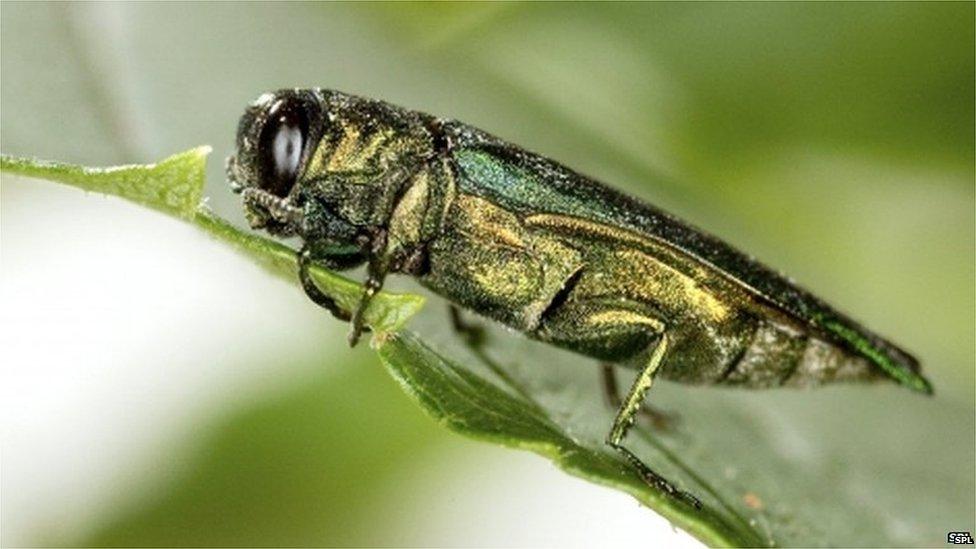Measuring the cost of an invasive tree killer
- Published

The tiny emerald ash borer arrived in the US in 2002 and has since killed tens of millions of ash trees
For the first time, a study has attempted to assess the devastation caused by the emerald ash borer in US forests that shape river systems.
Researchers discovered a range of ways that the ecologically vital habitat is being systematically changed at a landscape level.
Since it was discovered in the US in 2002, the invasive insects have wiped out tens of millions of ash trees.
The findings will appear in the journal Forest Ecology and Management.
Since it was first recorded in Michigan, the tiny wood-boring beetle has spread across the north-eastern reach of the US, killing tens of millions of ash trees.
The cost to the nation's economy has been estimated to exceed $10bn.
However, a team from Michigan State University saw that little attention had been paid to how the invasion was changing the face of riparian (water/river system) forests.
Vulnerable wetlands
"In North America, green and black ash [trees] are two very important species, ecologically speaking," explained co-author Patrick Engelken from the university's department of entomology.
"The wetland habitats are often inundated during spring wet months. The tree species that grow there have to be really tolerant of having lots of water on their roots," he added.
"And they are functionally linked to these waterways where the nutrient supply within these stream systems is directly mediated by these surrounding forests"

Green and black ash trees dominate riparian forests in Michigan, but are vulnerable to the invasive beetle
Mr Engelken also said that other factors were also regulated by these forests, such as nutrition distribution, leaf litter depositions, temperature moderation and shading.
When the team examined the impact of 15 years of the invasive emerald ash borer across forests in three watersheds, although there was widespread mortality, the legacy on the ground varied widely.
"The trees in south east Michigan had begun to really decay and break down and accumulate," Mr Engelken told BBC News.
"We were climbing over piles of dead ash trees in open canopy areas that used to be dense overstorey (the uppermost canopy level of a forest, formed by the tallest trees).
"And about 120 miles to the west, we would see the standing dead trees. These were going to have really large scale impacts on the environment; the riparian forest floor and in the streams as well.
Surprising adaptations
The researchers also found a lot of log jamming in the water system, which had the potential to change the way the river systems behaved during periods of flooding.
However, they said that some of the other effects that they encountered were not what they had necessarily expected to see.
"Ash trees still remain highly abundant in the sapling strata, in the understory. By far, the dominant species - in canopy gaps at least - were species of ash, primarily green ash.
Mr Engelken explained that this was probably the result of emerald ash borer densities being much lower than they were during the invasion's peak. This was primarily a result of the insects' food source, mature ash trees, being gone.
"We have this healthy cohort of ash in the understory (a layer of vegetation below the forest's main canopy) where if the (ash borer) pressure remains low on them, you might start to see some ash begin to recover and begin to create a new overstorey of ash in the coming years," he said.
Another thing that surprised the researchers was the dense growth of herbaceous (non-woody) plants in the places where the canopy had gone.
"We had expected to see invasive plant species move in and dominate," Mr Engelken explained.
"But what we saw in almost every single site was that the understorey is completely covered in dense herbaceous masses. Sedges that not only seemed to be outcompeting seedlings but invasive species as well."
Mr Engelken warned that the conversion of these areas of habitat to open sedge meadows from ash-dominated riparian forests could have lasting effects as far as providing shade or nutrients to watercourses.
He said that riparian forests had been overlooked or neglected when it came to the effects of the emerald ash borer invasion.
However, he said that if policymakers placed a little more urgency on these important habitats then the legacy from the emerald ash borer will have been much reduced.
"Ash trees are really good mass trees; they put out a lot of seeds and they grow fast or hardy," he observed.
"It would just take a little bit of foresight to try to keep some big, mature trees to perhaps maintain these habitats.
"Restoration is difficult. It's a lot more difficult than thinking about them beforehand. I would say just think about these riparian corridors and the species occupying them, as they are... really important ecosystems."